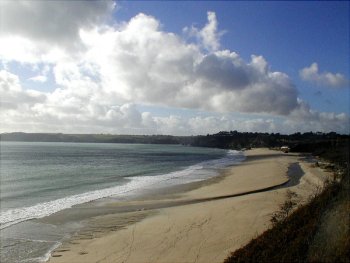

 |
||||||||||||||
|
|
||||||||||||||
|
Carlyon Bay Watch was formed to try to preserve these beaches at Carlyon Bay for the use and enjoyment of local residents and holidaymakers alike. This photo shows the three beaches - Crinnis, Shorthorn and Polgaver - which together make up Carlyon Bay near St Austell as it looked before clearing work started on the site. This is the area which has been earmarked for a huge development of over 500 apartments, splendidly called 'The Beach'. NEW ON THE WEBSITE: The footpaths issue hots up - read the latest on our new Public Access page Plans for a massive sea-defence scheme have already been rejected by the Government after a Public Inquiry and a long campaign spear-headed by Carlyon Bay Watch.But the fight is by no means over. The developers have gone to appeal, claiming that the Government Inspector and the Secretary of State were complete idiots to turn down their plans. That appeal is due to be heard on 1st December 2008 at the High Court in London. In the meantime we are left with the eyesore that is the wreckage of the old Coliseum building, with piles of rubble along the beaches and with an illegal and ugly line of rusting steel shuttering. The developer, Ampersand, has been ordered to remove the shuttering by the local authority, Restormel Borough Council, but has been given three years to do so. The shuttering and line of massive boulders dumped in front of it mean it is impossible to walk the length of the beach at high tide. Before Ampersand began work, members of the public were able to walk along the beach whatever the state of the tide and through woodland at the back - much of which has now been destroyed. These issues of public access have not yet been resolved. ______________________________________________ LATEST NEWS FOOTPATHS APPEAL A decision to register a footpath at Carlyon Bay as a public right of way is to be disputed by Ampersand. The company has decided to appeal against the decision to put the route from Beach Road down past the Old Coliseum building at Crinnis officially on maps. In April 2008 Cornwall County Council finally bowed to years of pressure from a group of local walkers led by Mrs Gloria Price to register several footpaths at Carlyon Bay as official rights of way on maps. They are:
The Council said any objectors had until 3 July 2008 to submit their reasons and the matter would then be referred to the Secretary of State for the Environment who is likely to appoint a public inquiry inspector. Although Ampersand has said that public access to the beaches will be maintained, the registering of these paths means unrestricted access to the beach would be enshrined in law. Carlyon Bay Watch felt relying on Ampersand's assurances could lead to public access being by permission only and over time could be restricted or lost. Responding to Ampersand's announcement of an appeal, Gloria Price says it has had ample opportunity to submit evidence during the five years the matter has been with Cornwall County Council. Find out more about the access and footpath issue. RADIO DATEHe said it would be several years before Restormel Council's order for the beaches to be cleaned up and the iron shuttering to be removed would be carried out. He emphasised that Carlyon Bay Watch was not opposed to any development, but wanted to see a proportionate, sustainable, environmentally responsible construction on Crinnis - the brownfield site occupied by the Coliseum - rather than the huge development envisaged by Ampersand across nearly the whole of Carlyon Bay. __________________________________________________________CARLYON BAY WATCH Carlyon Bay Watch (CBW) was formed by a group of local residents to raise awareness of the issues surrounding this development which, when completed, would dump a 'village' the size of Mevagissey on this beach. Carlyon Bay has been a popular resort since the early part of the twentieth century. During the 1930s the complex known as The Cornwall Coliseum was built, with a Wimpy Bar and a nightclub added later. The Coliseum was a highly popular entertainment venue in the 1970s and 1980s but became semi-derelict after it fell out of use. CBW has no objection to a new use being found for the original Coliseum site - the only part of the Carlyon Bay beaches which can be described as "brownfield". But the sheer scale of the intended development, given planning permission 18 years ago, would spread concrete over not only Crinnis but Shorthorn as well. Buildings up to five storeys high would cover the beaches down to the shoreline and up to the cliffs to the rear, all defended by a massive sea wall. With growing awareness of climate change and predictions of steadily rising sea levels, Carlyon Bay Watch believes this ambitious scheme is madness. Proposals in 2005 to build a bigger sea defence scheme, which entailed artificially extending the beach area in front of the sea wall, needed new planning permission and after much hard work by Carlyon Bay Watch to raise public awareness of the various environmental and safety issues, the plans were 'called in' by the Government. During five weeks of hearings in November and December 2006, Cornwall County Council and the Environment Agency joined Carlyon Bay Watch in arguing against the sea defence proposals. The planning inspector subsequently reported that the scheme breached government policies on sustainable development, building in a coastal zone and on the undeveloped coastline of Cornwall. He also said traffic generated would cause "material residual harm to amenity and to some extent highway safety considerations". Ruth Kelly, who replaced John Prescott as Secretary of State for Communities and Local Development, agreed with the inspector's recommendation and refused permission for the sea defence scheme in June 2007.
|
|
|
|
|
| Site Map |
